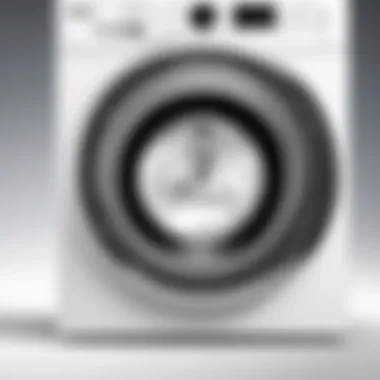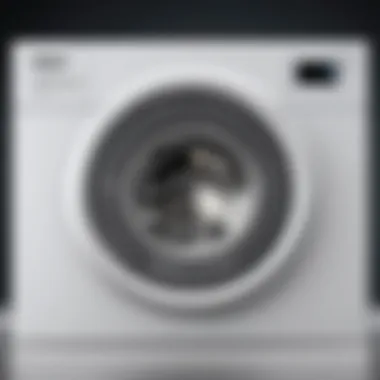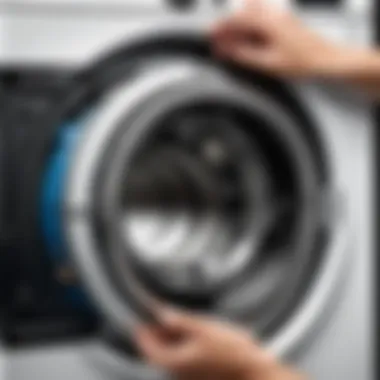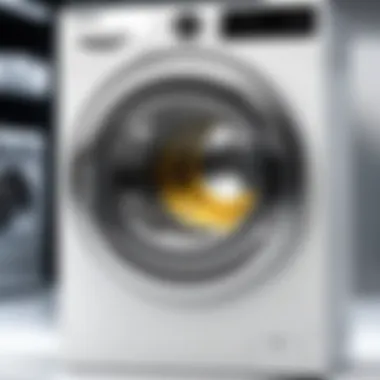Understanding Whirlpool Front Load Washer Bearings


Intro
In any washing machine, the importance of components often goes unnoticed. One such critical part in Whirlpool front load washers is the bearing system. These bearings play a vital role in the overall performance and longevity of the appliance. Understanding how these components work, their types, and signs of wear can empower users to maintain their machines effectively.
This guide delves into the nuances of bearings in Whirlpool front load washers. It explores their specifications, functions, and the potential impact of failure on the appliance's operation. We will also detail how to recognize bearing failure, the steps for replacement, and strategies for preventive maintenance.
Equipped with this knowledge, users can ensure their washing machines remain efficient and durable for years to come.
Prelude to Washer Bearings
In modern washing machines, particularly Whirlpool front load washers, bearings play a crucial role. Understanding these components is essential for anyone seeking to maintain or troubleshoot washing machines effectively. Bearings are integral not only for smooth operations but also for extending the lifespan of the appliance.
Definition of Washing Machine Bearings
Washing machine bearings are mechanical parts that support the drum of the washer. They are typically made of metal and are designed to reduce friction between the rotating drum and the stationary components. Bearings allow the drum to spin freely and maintain alignment during cycles. Failure to understand their function may lead to operational issues, as these components directly influence the efficiency of the machine.
Importance in Appliance Functionality
The functionality of washers heavily depends on the condition of their bearings. Here are a few specific benefits of bearings that highlight their importance:
- Smooth Operation: Bearings ensure that the drum rotates smoothly, which is vital for washing clothes effectively without excessive noise.
- Load Support: They support the weight of the drum and its contents, helping maintain balance during high spin speeds.
- Durability: Quality bearings reduce wear and tear on the gear and drum. This durability leads to a longer life for the washing machine.
- Vibration Dampening: They help minimize vibration, ensuring the machine remains stable during operation.
Properly functioning bearings can greatly enhance the washing experience, reducing noise and increasing appliance longevity.
Types of Bearings Used in Whirlpool Washers
In Whirlpool washers, bearings play a crucial role in ensuring a smooth and efficient operation. Understanding the types of bearings used in these appliances allows users to appreciate their functionality and importance. Each bearing type contributes differently, impacting the overall performance and longevity of the washing machine. Choosing the right bearings is vital for optimal functioning. Therefore, it is essential to discuss the key types found in Whirlpool washers, namely ball bearings, roller bearings, and spherical bearings.
Ball Bearings
Ball bearings are one of the most common types found in Whirlpool washers. They consist of a set of balls that reduce friction between moving parts. The design of ball bearings allows them to handle both axial and radial loads, making them extremely versatile. Their ability to maintain smooth rotation translates to better washing performance and less energy consumption.
Benefits of ball bearings include:
- Durability: They tend to have a long life due to their robust construction.
- Efficiency: Ball bearings minimize friction, leading to better energy efficiency during washing cycles.
- Noise Reduction: They operate quietly, enhancing the overall user experience.
However, proper maintenance is vital to ensure their longevity. Users should check for signs of wear, as failure to maintain ball bearings may lead to unusual noises or excessive vibrations during operation.
Roller Bearings
Roller bearings are another type frequently used in Whirlpool washers. Unlike ball bearings, roller bearings utilize cylindrical rollers instead of balls. This small change allows roller bearings to support larger loads, making them suitable for heavy-duty applications. Roller bearings are known for their strength and ability to reduce friction effectively, which helps in providing a smooth washing experience.
Key characteristics of roller bearings are:
- Load Capacity: They can support heavier loads than ball bearings, which is useful for larger loads of laundry.
- Stability: Roller bearings offer enhanced stability for the washer drum, reducing the risk of misalignment and enhancing performance.
- Cost-Effectiveness: Though they may have a higher initial cost, their efficiency in load handling can save on potential repair costs in the long run.
Still, users should be aware of the fact that roller bearings might require more attention for lubrication compared to other types.
Spherical Bearings
Spherical bearings are less common but serve an essential purpose in Whirlpool washers. They are designed to accommodate angular misalignment between the drum and the washer body, providing flexibility during operation. Spherical bearings are especially beneficial in washers that handle uneven loads or when the drum may shift during the wash cycle.


Distinct features of spherical bearings include:
- Misalignment Compensation: They allow for better handling of off-center loads, which can enhance overall washing performance.
- Resilience: Spherical bearings are built to withstand dynamic forces that occur during the wash cycle.
- Longevity: With proper care, these bearings can provide a reliable solution for many washing cycles.
It is important for users to understand these characteristics and ensure that spherical bearings remain adequately lubricated to avoid premature wear and tear.
Proper understanding of the bearing types can greatly extend the lifespan of your Whirlpool washer, ensuring it continues to function efficiently.
Functionality of Bearings in Front Load Washers
The functionality of bearings in front load washers is crucial to the overall performance and longevity of the appliance. By understanding how bearings work, users can appreciate their significance in ensuring efficient washing and preventing premature wear. Bearings serve several key functions that contribute to the operational effectiveness of a washing machine, from supporting the drum to allowing smooth rotation.
Support for Drums
Bearings provide essential support for the drum in a front load washer. The drum must be able to spin freely without any obstruction to maintain optimal washing cycles. Bearings help achieve this by allowing the drum to pivot and rotate around a fixed axis. This support also counters the weight of wet clothes, preventing strain on other components. A properly functioning bearing system ensures that the drum remains centered, enhancing washing performance. When the drum is well-supported, it can perform at high speeds, which improves water removal at the end of a cycle.
Facilitation of Smooth Rotation
Smooth rotation is another critical aspect of the functionality of bearings in front load washers. The motion of the washer's drum should be seamless to provide the most effective cleaning. Bearings reduce friction between the moving parts, allowing the drum to rotate effortlessly. This smooth operation not only increases energy efficiency but also minimizes wear on the motor and other mechanical parts. Poorly functioning bearings can lead to uneven spinning, resulting in subpar wash results and increased energy consumption.
Vibration Dampening
Vibration dampening is an often-overlooked but important function of bearings in these washers. When the drum rotates, it can create vibrations that may disturb the balance of the machine. Bearings help to absorb and dampen these vibrations, ensuring that the washer remains stable during the wash cycle. Effective vibration control is vital for maintaining the integrity of the machine and prevents excessive wear and tear. Additionally, it enhances noise reduction, making the appliance quieter during operation.
Properly functioning bearings not only prolong the life of the washing machine but also improve its overall performance and efficiency.
In summary, the functionality of bearings in front load washers centers on support, smooth rotation, and vibration dampening. Understanding these roles helps users recognize the importance of maintaining the bearing system to ensure optimal washing performance.
Signs of Bearing Wear and Failure
Understanding the signs of bearing wear and failure is crucial for maintaining the performance and longevity of Whirlpool front load washers. Bearings play a vital role in supporting the drum and ensuring smooth operation. Any irregularities can lead to severe problems, including inefficient washing and potential damage to other components. By recognizing the early signs of bearing issues, users can take proactive measures to address the situation before it escalates into costly repairs or complete appliance failure.
Unusual Noises During Operation
One of the first indications of bearing wear is the presence of unusual noises during the washing cycle. These noises can often manifest as grinding, rumbling, or loud squeaking sounds. Bearings in good condition operate quietly, supporting the drum's movement seamlessly. If users notice these sounds, it may be a sign that the bearings are beginning to fail.
The source of these sounds can be due to the deterioration of the bearing surfaces, which causes metal-on-metal contact. This condition could become worse if not addressed quickly, leading to further damage to the washer. Regularly listening for unusual noises while the washer is in operation can provide critical insight into its health.
Excessive Vibration of Machine
Another notable sign of bearing wear is excessive vibration. While some vibration is normal during operation, particularly in front load models, significant increases can indicate a problem with the bearings. This vibration may not only be felt in the washer but can also affect surrounding surfaces and items in the home.
Excessive vibrations occur when the bearings are misaligned or worn out, leading to an imbalance in the drum. This situation may cause the washer to move or shift while it runs, resulting in potential damage to the appliance or surrounding structures. Users should monitor the vibrations and take note if the intensity increases over time as it could suggest a need for immediate attention.
Leakage of Water
Water leakage is a serious sign of bearing failure that requires immediate investigation. If users notice water pooling under or around the washer, it may be due to a failure of the bearings or related seals. Worn bearings can cause misalignment, which may lead to improper sealing of the drum and allow water to escape.
Ignoring signs of leakage can not only lead to water damage in your home but may also indicate that the washer is working harder than necessary, leading to further complications. Identifying and addressing any leaks quickly is essential for ensuring that the washer remains functional and does not incur further damage.
Drum Misalignment
Finally, drum misalignment is a critical sign that the bearings may be failing. A properly functioning washer drum sits securely within the washer and rotates smoothly. If the drum appears tilted or does not move freely, it suggests that the bearings are worn out or have suffered damage.


Misalignment can cause uneven wear on the drum, leading to further complications down the line. Users can check for drum misalignment by gently shaking the drum or observing its rotation during operation. Ensuring that the drum is aligned can help maintain operational efficiency and prolong the washer's lifespan.
By closely monitoring these signs of bearing wear and failure, users can take informed steps toward maintaining their Whirlpool front load washers. Regular maintenance and timely intervention can lead to enhanced performance and increased longevity of the appliance.
Replacing the Bearings in Whirlpool Washers
Replacing the bearings in Whirlpool washers is an essential process that ensures the appliance operates smoothly and efficiently. Bearings are critical components that support the washing drum, allowing it to rotate freely without causing undue friction or wear on other parts. When they begin to fail, further damage can occur, leading to costly repairs or even the need for a complete machine replacement. Understanding the process of bearing replacement can provide significant benefits, such as prolonging the lifespan of the washer and maintaining its performance.
Tools Required for Replacement
Before starting the bearing replacement process, it is important to gather the necessary tools. The right tools will make the job easier and more efficient. Here are some tools you will likely need:
- Socket Set: Various sizes, particularly for removing the outer drum.
- Screwdrivers: Both flathead and Phillips.
- Pry Bar: For assisting with drum removal.
- Bearing Puller: Helps in extracting old bearings from their housing.
- Hammer: For tapping bearings into place.
- Grease: High-quality lubricant is essential for new bearings.
Make sure to have a clean workspace to organize the parts removed from the washer.
Step-by-Step Replacement Process
The following steps outline a systematic approach to replacing the bearings in your Whirlpool washer:
- Unplug the Washer: Safety first. Disconnect the appliance from the power source.
- Remove the Front Panel: Use screwdrivers to take off the front panel, allowing access to the drum and bearing assembly.
- Take Out the Drum: Detach the outer drum by unscrewing and gently lifting it out. This requires care to avoid damage.
- Extract Old Bearings: Use a bearing puller to safely remove the worn bearings from their housing. This may require some effort.
- Clean the Area: Before installing the new bearings, clean the housing thoroughly to remove any debris or old grease.
- Install New Bearings: Carefully press the new bearings into place, ensuring they fit snugly in the housing.
- Reassemble the Drum: Fit the outer drum back into the machine, securing it with screws and ensuring all components align correctly.
- Reconnect the Front Panel: Reattach the front panel to complete the assembly.
- Test the Washer: Plug the washer back in and run a test cycle to ensure everything is functioning perfectly.
Tips for Successful Installation
To ensure a successful installation of the new bearings, consider the following tips:
- Follow the Manual: Consult the Whirlpool washer manual for specific instructions related to your model.
- Be Gentle: Avoid excessive force when removing or installing bearings to prevent damage.
- Use the Right Bearings: Purchase original Whirlpool bearings that meet the specified size and material requirements.
- Take Your Time: Rushing the process can lead to mistakes. Careful attention to each step is important.
- Test Before Full Use: After installation, run a short cycle to check for any signs of irregular noises or improper rotation.
By following these guidelines, you can effectively replace the bearings in your Whirlpool washer, ensuring optimal performance and longevity of the appliance.
Preventive Maintenance for Washer Bearings
Maintaining the functionality of Whirlpool front load washer bearings is crucial for the overall efficiency and longevity of the appliance. Preventive maintenance is a proactive approach that helps identify potential issues before they escalate into costly repairs. By regularly caring for these bearings, users can ensure smooth operation and avoid inconvenient breakdowns. Solid maintenance practices will not only extend the lifespan of the bearings, but also enhance the effectiveness of the washer itself.
Regular Inspection Practices
Frequent checks of the washer bearings should be standard practice for any owner. This involves visually examining the areas around the bearings for signs of wear or damage. Users should look for rust, discoloration, or any physical changes. Using a flashlight can help in identifying smaller issues that might go unnoticed. Additionally, placing a hand on the washer during operation can reveal unusual vibrations or noises. Noises such as grinding or thumping can indicate bearing problems that need addressing.
Maintaining Proper Load Capacity
Every washer has a specified load capacity that users must respect. Overloading a washer can stress the bearings and lead to premature failure. It is essential to follow manufacturer guidelines for load limits. If a user regularly exceeds these limits, they may face increased wear on the bearings and a shorter lifespan for the entire appliance. Additionally, underloading can also strain the washer's mechanical components, though this is often less severe than the damage caused by overloading. Understanding and adhering to load capacity is fundamental in ensuring the longevity of the washer bearings.
Using Correct Detergents
The choice of detergent can significantly influence the health of washer bearings. Not all detergents are created equal; some may contain harsh chemicals that can corrode components over time. Using high-efficiency (HE) detergents is advisable for front load washers, as they produce less suds and minimize the risk of residue buildup. Residue can lead to moisture retention and consequently damage bearings. Users should also avoid overusing detergents. Following the manufacturer's recommendations for the type and amount of detergent can help maintain proper washer function and prevent bearing wear.
The key to maintaining your Whirlpool washer bearings lies in a combination of regular inspections, load management, and careful selection of detergent.
By implementing these preventive maintenance strategies, users of Whirlpool front load washers can extend the lifespan of their machines. Awareness of bearing health not only enhances washing performance but can also save significant costs in potential repairs.
Impact of Quality Bearings on Washer Performance
The quality of bearings in Whirlpool front load washers plays a significant role in the overall performance of these appliances. This section emphasizes the necessity of high-quality bearings for efficient washing, the longevity of the machine, and cost savings over time. By recognizing the impact of bearings’ quality, users can appreciate how crucial these components are in maintaining optimal washing functionality.


Efficiency in Washing
Quality bearings directly contribute to the effectiveness of the washing cycle. When bearings function properly, they allow the drum to rotate smoothly, enhancing the agitation process. This smooth rotation results in better water circulation and detergent distribution during washes.
- Reduced Energy Consumption: High-quality bearings minimize friction. This results in less energy needed for the motor to operate effectively, leading to lower energy bills.
- Better Cleaning Results: When a washer operates efficiently, clothes receive more thorough cleaning. This means fewer cycles are needed for heavily soiled items, improving the overall washing experience.
- Lower Operating Noise: Quality bearings help maintain a quieter operation. This is essential for users who prefer minimal disturbance during functioning.
Long-Term Cost Effectiveness
Investing in quality bearings pays off in the long run through various cost-saving measures. High-quality bearings reduce the likelihood of premature failure, which can lead to expensive repairs or replacements. Users should consider the following aspects:
- Fewer Repairs: Quality bearings offer greater reliability. This translates into fewer repairs or replacements needed over the life of the washer, saving money on service calls and parts.
- Extended Appliance Lifespan: Durable bearings enhance the lifespan of the entire machine. Users can enjoy the appliance longer without the need for early replacement, thereby maximizing their investment.
- Increase in Resale Value: A well-maintained washer with high-quality bearings retains its value better than one with compromised components. If users decide to sell their washers, they often achieve a higher price for appliances that have superior bearings.
Focusing on quality bearings is a smart decision for anyone looking to maintain their Whirlpool washer’s performance and save on future costs.
In summary, the impact of quality bearings cannot be overstated. They play a critical role in the efficiency, cost-effectiveness, and overall functionality of Whirlpool front load washers. Understanding these elements will help users make informed decisions to enhance their appliance's performance.
Common Myths About Washer Bearings
Understanding the common myths surrounding washer bearings is essential for maintaining your Whirlpool front load washer effectively. These myths can lead to misunderstandings about the operation and life of bearings. Educating yourself helps in making informed choices which can lead to better appliance performance and longevity.
All Bearings are the Same
One prevalent myth is that all bearings function identically. This misconception overlooks the variety of bearings available and their specific applications.
Bearings differ in design, material, and intended use. For example, ball bearings, roller bearings, and spherical bearings each have distinct characteristics that make them more suitable for specific tasks. Using the correct type of bearing is crucial for optimal performance.
Consider this:
- Different designs manage loads differently.
- Some bearings excel in high-speed situations while others manage heavy loads.
- Mismatching bearing types can lead to premature failures or inefficiencies.
Using the appropriate bearings can result in smoother operation and extension of the washer’s lifespan.
Bearings Last Indefinitely
Another common myth is the belief that washer bearings last indefinitely. This notion can result in a lack of appropriate maintenance practices. While quality bearings have impressive longevity, they do not last without proper care. Environmental factors, usage patterns, and maintenance play significant roles in their longevity.
It is vital to recognize that:
- Wear and tear are natural over time.
- Regular inspections can help catch issues early.
- Prevention is always better than dealing with full system failure.
“Ignoring the signs of wear could lead to major breakdowns later.”
Being aware of these factors can assist users in developing a regular maintenance schedule, ultimately extending the life of the appliance. Therefore, disregarding these myths can lead to enhanced performance and reduced costs associated with repairs and replacements.
Epilogue
In this article, we have explored the vital role of washer bearings in Whirlpool front load washing machines. Understanding the significance of these components enhances user awareness of how they affect overall appliance performance.
Recap of Key Points
To summarize, we have covered several critical topics:
- Definition and Functionality: We defined what washer bearings are and illustrated their essential functions, including support for the drum, allowing smooth rotation, and dampening vibrations.
- Types of Bearings: We discussed the various types of bearings present in Whirlpool washers, such as ball, roller, and spherical bearings, each serving a unique purpose.
- Signs of Wear: Awareness of signs that indicate bearing wear can help in preventing significant damage or failure.
- Replacement Process: Understanding the replacement steps can empower users to undertake this task efficiently, saving time and money.
- Preventive Maintenance: Adopting regular maintenance practices can extend the life of the bearings and improve washer performance.
- Myth-Busting: Addressing common myths has clarified misconceptions surrounding washer bearings, contributing to informed decision-making.
Importance of Proper Maintenance
Proper maintenance of washer bearings is crucial. By conducting regular inspections and adhering to best practices, users can mitigate common bearing-related issues. This proactive approach helps in preventing unexpected failures, enhances washing efficiency, and ultimately contributes to the longevity of the appliance. Integrating suitable detergents and maintaining appropriate load capacities are also essential factors for reducing wear and tear on bearings.
By emphasizing the importance of these elements, users can enhance their understanding of appliance care and maintenance, thus ensuring optimal washing performance for years to come.







